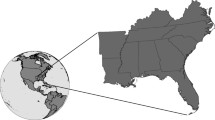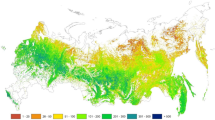Abstract
Forests of the United States and Russia can play a positive role in reducing the extent of global warming caused by greenhouse gases, especially carbon dioxide. To determine the extent of carbon sequestration, physical, ecological, economic, and social issues need to be considered, including different forest management objectives across major forest ownership groups. Private timberlands in the U.S. Pacific Northwest are relatively young, well stocked, and sequestering carbon at relatively high rates. Forests in northwestern Russia are generally less productive than those in the Northwestern U.S. but cover extensive areas. A large increase in carbon storage per hectare in live tree biomass is projected on National Forest timberlands in the U.S. Pacific Northwest for all selected scenarios, with an increase of between 157–175 Mg by 2050 and a near doubling of 1970s levels. On private timberlands in the Pacific Northwest, average carbon in live tree biomass per hectare has been declining historically but began to level off near 65 Mg in 2000; projected levels by 2050 are roughly what they were in 1970 at approximately 80 Mg. In the St. Petersburg region, average carbon stores were similar to those on private lands in the Pacific Northwest: 57 Mg per hectare in 2000 and ranging from 40 to 64 Mg by 2050. Although the projected futures reflect a broad range of policy options, larger differences in projected carbon stores result from the starting conditions determined by ownership, regional environmental conditions, and past changes in forest management. However, an important change of forest management objective, such as the end of all timber harvest on National Forests in the Pacific Northwest or complete elimination of mature timber in the St. Petersburg region, can lead to substantial change in carbon stores over the next 50 years.
Similar content being viewed by others
References
Adams, D. M. and Haynes, R. W.: 1996, ‘The 1993 timber assessment market model: Structure, projections, and policy simulations, Gen. Tech. Rep. PNW-GTR-368. Portland, OR: U.S. Department of Agriculture, Forest Service,’ Pacific Northwest Research Station. 58 p.
Adams, D. and Latta, G.: 2004, ‘Effects of a forest health thinning program on land and timber values in eastern Oregon,’ J. Forestry 102(8), 9–13.
Adams, D., Alig, R., McCarl, B., Winnett, S. and Callaway, J.: 1999, ‘Minimum cost strategies for sequestering carbon in forests’, Land Economics 75(3), 360–374.
Alexeyev, V. A. and Birdsey, R. A. (eds): 1998, ‘Carbon Storage in Forests and Peatlands of Russia’. Gen. Tech. Rep. NE-244. Radnor, PA: U.S. Department of Agriculture, Forest Service,' Northeastern Forest Experiment Station. 137 p.
Alexeyev, V. A., Markov, M. V. and Birdsey, R. A.: 2004, ‘Statistical Data on Forest Fund of Russia and Changing of Forest Productivity in the Second Half of 20th century, St. Petersburg Forest Ecological Center Publishers,’ St. Petersburg, Russia. 272 p.
Alig, R., Lewis, B. and Morris, P.: 1984, ‘Aggregate Timber Supply Analysis. USDA Forest Service. General Technical Report RM-GTR-106. USDA Forest Service Rocky Mountain Forest and Range Experiment Station,’ Ft. Collins, Colo.
Alig, R., Adams, D. and McCarl, B.: 1997, ‘Assessing effects of mitigation strategies for global climate change with an intertemporal model of the U.S. forest and agricultural sectors,’ Environmental and Resource Economics, 9, 259–274.
Alig, R., Zheng, D., Spies, T. and Butler, B.: 2000, ‘Forest cover dynamics in the Pacific Northwest west side: Regional trends and Projections’ Res. Pap. PNW-RP-522. Portland, OR: U.S. Department of Agriculture, Forest Service,' Pacific Northwest Research Station. 22 p.
Alig, R.: 2003, ‘U.S. landowner behavior, land use and land cover changes, and climate change mitigation’, Silva Fennica, 37(4), 511–527.
Alig, R., Plantinga, A., Ahn, S., and Kline, J.: 2003, ‘Land use changes involving forestry in the United States: 1952 to 1997, with projections to 2050’ Gen. Tech. Rep. PNW-GTR-587. Portland, OR: USDA Forest Service, Pacific Northwest Research Station. 92 p.
Alig, R. and Butler, B.: 2004, ‘Forest cover changes in the United States: 1952 to 1997, with projections to 2050' Gen. Tech. Rep. PNW-GTR-613, Portland, OR: U.S. Department of agriculture, forest service,' Pacific Northwest Research Station. 106p.
Alig, R., Kline, J., and Lichtenstein: 2004, ‘Urbanization on the U.S. landscape: Looking ahead in the 21st century’, Landscape and Urban Planning 69 219–234.
Aksenov, D., Dobrynin, D., Dubinin, M. et al.: 2000, ‘Atlas of Russia's Intact Forest Landscapes, Biodiversity Conservation Center, Greenpeace Russia, International Socio-Ecological union,’ World Resources Institute, Moscow, Russia.
Birdsey, R., Alig, R., and Adams, D.: 2001, ‘Mitigation options in the forest sector to reduce emissions or enhance sinks of greenhouse gases’ In: Joyce, L. and Birdsey, R., eds., The Impacts of Climate Change on America's Forests. Gen. Tech. Rep. RMRS-GTR-59. Fort Collins, CO: USDA Forest Service,' Rocky Mountain Research Station, 112–131. Chapter 8.
Caspersen, J., Pacala, S., Jenkins, J., Hurtt, G., Moorcroft, P., and Birdsey, R.: 2000, ‘Contributions of land-use history to carbon accumulation in U.S.’, Forests Science 290(5494), 1148–1151.
Conard, S. G., Sukhinin, A. L. Stocks, B. et al.: 2002, ‘Determining effects of area burned and fire severity on carbon cycling and emissions in Siberia’, Climatic Change, 55(1), 197–211.
Filimonov, B. K., Kukuev, Y. A, Strakhov, V. V., Filipchuk, A. N., Dyakun, F. A., Sdobnova, V. V. and Danilova, S. V.:1995, ‘Forest fund of Russia’ Statistical summary. (survey of January 1, 1993; in Russian).
Harmon, M. E.: 2001, ‘Carbon sequestration in forests: Addressing the scale question,’ Journal of Forestry 99(4), 24–29.
Harmon, M. E. and Marks, B.: 2002, ‘Effects of silvicultural treatments on carbon stores in forest stands,’ Canadian Journal of Forest Research 32, 863–877.
Haynes, R., tech. coord.: 1990, ‘An analysis of the timber situation in the United States: 1989–2040. Gen. Tech. Rep. RM-1995. Ft. Collins, CO., U.S. Department of Agriculture, Forest Service,’ Pacific Northwest Research Station. 286 p.
Haynes, R., tech. coord.: 2003, ‘An analysis of the timber situation in the United States: 1952 to 2050. Gen. Tech. Rep. PNW-GTR-560. Portland, OR, U.S. Department of Agriculture, Forest Service,’ Pacific Northwest Research Station. 254 p.
Houghton, R. A., Hackler, J. L., and Lawrence, K. T.: 1999, ‘The U.S. carbon budget: Contributions from land-use change,’ Science 285, 574–578.
Ince, P. 1999, ‘Long-range outlook for U.S. paper and paperboard demand, technology, and fiber supply-demand equilibria,’ in: Proceedings of the society of American Foresters 1998 National Convention. Bethesda, MD: Society of American Foresters, 330–343.
Kasischke, E. S. Bergen, K. et al., 1999, ‘Satellite imagery gives clear picture of Russia's boreal forest fires’, EOS, Transactions, American Geophysical Union 80(13), 141–147.
Kasischke, E. S. and Bruhwiler, L. M.: 2002, ‘Emissions of carbon dioxide, carbon monoxide and methane from boreal forest fires in 1998,’ Journal of Geophysical Research 108 (D1) 8146, doi:10.1029/2001JD000461.
Kauppi, P., Sedjo, R., Apps, M., Cerri, C., Fujimori, T., Janzen, H., Krankina, O., Makundi, W., Marland, G., Masera, O., Nabuurs, G.-J., Razali, W. and Ravindranath, N.H.: 2001, ‘Technical and economic potential of options to enhance, Maintain and manage biological carbon reservoirs and geo-engineering’ in: Climate change 2001: Mitigation. Contribution of working group III to the third assessment report of the intergovernmental panel on Climate Change. (IPCC). Pp. 301–343.
Krankina, O. N., Fiorella, M., Cohen, W., and Treyfeld, R. F.: 1998, ‘The use of Russian forest inventory data for carbon budgeting and for developing carbon offset strategies’ World Resource Review 10(1), 52–66.
Krankina, O. N., Treyfeld, R. F., Harmon, M. E., Spycher, G., and Povarov, E. D.: 2001, Coarse woody debris in the forests of St. Petersburg region, Russia, Ecol. Bull. 49, 93–104.
Krankina, O. N., Harmon, M. E., Cohen, W. B., et al. 2004a, ‘Carbon stores, sinks, and sources in forests of northwestern Russia: Can we reconcile forest inventories with remote sensing results?’ Climatic Change 67(2–3), 257–272.
Krankina, O. N., Bergen, K. M., Sun, G., Masek, J. G., Shugart, H. H., Kharuk, V., Kasischke, E., Cohen, W. B., Oetter, D. R. and Duane, M. V.: 2004b, Northern Eurasia: Remote sensing of boreal forest in selected regions in: G. Gutman et al. (eds.), Land Change Science: Observing, Monitoring, and Understanding Trajectories of Change on the Earth's Surface. Series: Remote Sensing and Digital Image Processing, Vol. 6. Springer E-book, pp.123–138.
Kukuev, Y. A., Krankina, O. N., and Harmon, M. E.: 1997, ‘The forest inventory system in Russia,’ Journal of Forestry, 95(9), 15–20.
Kurz, W. A. and Apps, M. J.: 1999, A 70-year retrospective analysis of carbon fluxes in the Canadian forest sector.Ecological Application. 9(2): 526–547.
McCarl, B., Adams, D., Alig, R., Burton, D. and Chen, C.: 2000. Effects of global climate change on the U.S. forest sector: response functions derived from a dynamic resource and market simulator. Climate Research. 15: 195–205.
Mills, J. and Kincaid, J.:1992, ‘The aggregate timberland analysis system – ATLAS: A comprehensive timber projection model,’ Gen. Tech. Rep. PNW-GTR-281. Portland, OR: USDA Forest Service, Pacific Northwest Research Station. 160p.
Murray, B., Prisley, S., Birdsey, R., and Sampson, N.: 2000, Carbon sinks in the kyoto protocol: Potential relevance for U.S. forests. Journal of Forestry. 98: 6–11.
Plantinga, A. and Birdsey, R.:1993, ‘Carbon fluxes resulting from U.S. private timberland management’, Climatic Change. 23: 37–53.
Shvidenko, A. and Nilsson, S.: 2003, A synthesis of the impact of Russian forests on the global carbon budget for 1961–1998. Tellus B.
Smith, W. B., Vissage, J., Sheffield, R. and Darr, D.: 2001, ‘Forest resources of the United States, 1997' Gen. Tech. Rep. NC-219. St. Paul, MN: U.S. Department of Agriculture, Forest Service, North Central Research Station. 190 p.
Treyfeld, R. F., Kobak, K. I. and Grjazkin A.V.: 2003, ‘The dynamic of carbon fund in a live biomass of the Leningrad region forest,’ (eds), in Grjaznov, S. E., Kuzminykh, Y. V., Krankina, O. N., and Belgavskaya, M. V., Dynamics of Carbon Store in the Forest of the Northwest: Ecology, Economics and Politics, Works of the International Science and Technology Conference, Forest Technical Academy, 2003, St. Petersburg, Russia St. Petersburg Technical Academy, 2003, pp. 21–38.
Turner D. P., Koerper G. J., Harmon M. E, and Lee, J.: 1995, ‘A carbon budget for forests of the conterminous United States,’ Ecological Applications. 5: 421–436.
U.S. Global Change Research Program.: 2000, ‘Our changing planet’, A Report by the Subcommittee on Global Change Research, Committee on Environment and Natural Resources of the National Science and Technology Council A Supplement to the President's Fiscal Year 2000 Budget.
United Nations Economic Commission for Europe (UNECE)/FAO. 2000. Forest resources of Europe, CIS, North America, Australia, Japan, and New Zealand (industrialized temperature/boreal countries). New York, USA and Geneva, Switzerland, UN.
Waggoner, P. E.: 1994, ‘How much land can ten billion people spare for nature ? Council for Agricultural Science and Technology,’ Task Force Report No. 121. Ames, IA, 64pp.
Author information
Authors and Affiliations
Corresponding author
Rights and permissions
About this article
Cite this article
Alig, R.J., Krankina, O., Yost, A. et al. Forest Carbon Dynamics in the Pacific Northwest (USA) and the St. Petersburg Region of Russia: Comparisons and Policy Implications. Climatic Change 79, 335–360 (2006). https://doi.org/10.1007/s10584-006-9077-7
Received:
Accepted:
Published:
Issue Date:
DOI: https://doi.org/10.1007/s10584-006-9077-7




